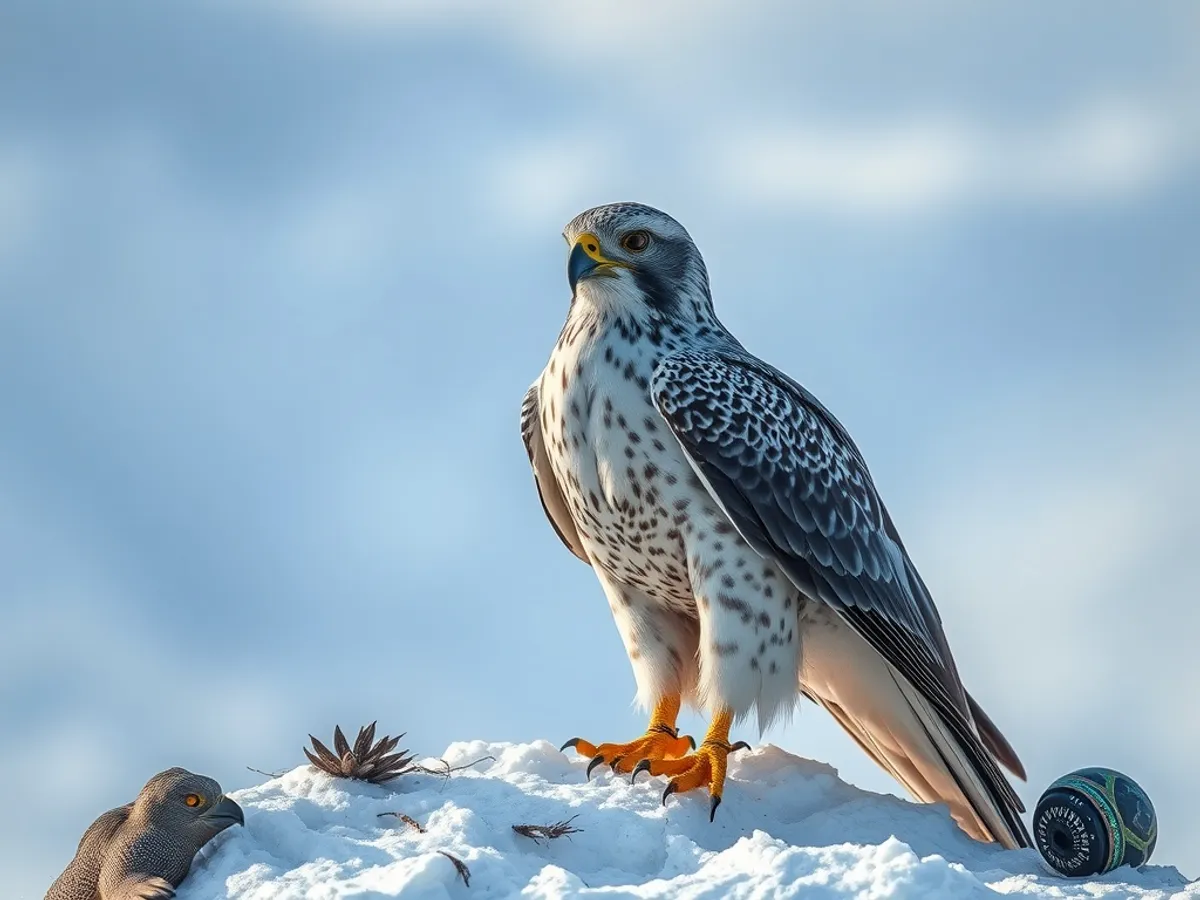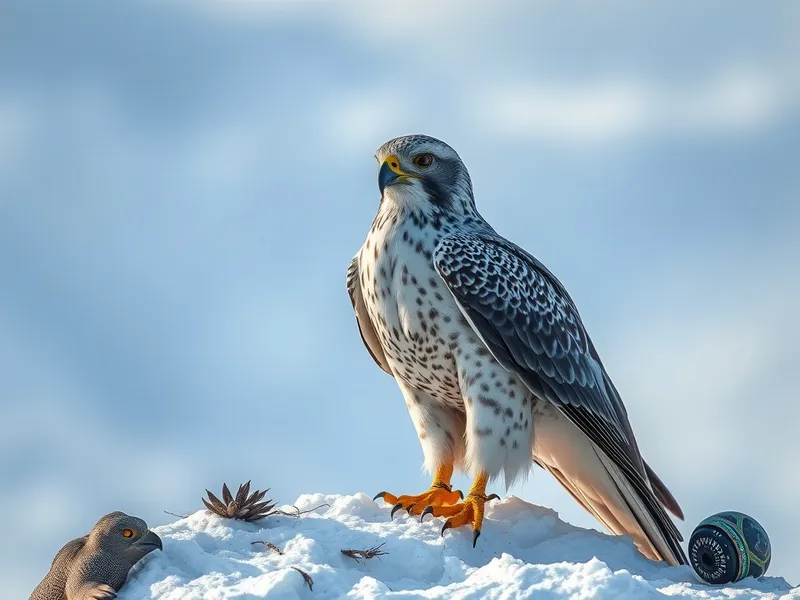
Gyrfalcon
Falco rusticolus

Meet the Gyrfalcon
The Gyrfalcon is the largest species of falcon in the world, renowned for its powerful build and stunning plumage that ranges from pure white to dark gray. Native to the Arctic and sub-Arctic regions, this formidable raptor is adapted to cold environments and open tundra landscapes. Gyrfalcons are apex aerial predators, often preying on birds and mammals, and are celebrated for their exceptional speed and agility in flight. Highly valued in falconry for centuries, they remain elusive in the wild due to their remote habitats and low population density.
Classification
Bird
Habitat
Arctic tundra and mountainous regions
Diet
Carnivore
Lifespan
13-20 years
Conservation
Least Concern
Weight
1.0–2.1 kg
📖Fascinating Facts
Largest Falcon
The Gyrfalcon is the largest member of the falcon family, with a wingspan reaching up to 1.6 meters.
Arctic Specialist
Gyrfalcons are specially adapted to survive the extreme cold of the Arctic and sub-Arctic, thriving in tundra and mountainous terrain.
Royal Falcon
Historically, only nobility and royalty were allowed to own Gyrfalcons, making them a symbol of status and prestige.
📋Detailed Description
The Gyrfalcon (Falco rusticolus) is the largest extant falcon species, with females typically weighing 1,400–2,100 grams and males 950–1,300 grams, and a wingspan ranging from 110 to 160 cm. Its robust, broad-chested body, long pointed wings, and relatively short tail are well-adapted for powerful, sustained flight over vast Arctic landscapes. Plumage exhibits remarkable polymorphism, ranging from nearly pure white (common in Greenland and Iceland) to dark slate-gray or brown morphs, with intermediate forms also present; this variation is thought to provide camouflage against different backgrounds. The beak is strong and hooked, with a pronounced 'tooth' for dispatching prey. Eyes are large and adapted for acute vision in low-light Arctic conditions. Gyrfalcons are solitary outside the breeding season, fiercely territorial, and occupy large home ranges (often exceeding 300 km²). They are apex aerial predators, preying mainly on medium-sized birds such as ptarmigan, waterfowl, and seabirds, but will also take mammals like Arctic hares and lemmings. Their flight is characterized by powerful, direct wingbeats interspersed with glides, and they are capable of high-speed pursuits and agile maneuvers. Nests are typically placed on inaccessible cliff ledges, sometimes reusing old raven or eagle nests. Gyrfalcons exhibit pronounced sexual dimorphism, with females up to 30% larger than males—a trait common in raptors, possibly related to division of labor during breeding.
💡 Did you know?
Unlike most falcons, Gyrfalcons do not build their own nests but instead reuse the abandoned nests of other large birds such as ravens or golden eagles.
🔬Research & Sources
Wikipedia Summary
The gyrfalcon, also abbreviated as gyr, is a bird of prey from the genus Falco and the largest species of the family Falconidae. A high-latitude species, the gyrfalcon breeds on the Arctic coasts and tundra, the islands of northern North America and the Eurosiberian region, where it is mainly a resident species. Some gyrfalcons disperse more widely after the breeding season or in winter, and individual vagrancy can take birds for long distances. Its plumage varies with location, with birds being coloured from all-white to dark brown. These colour variations are called morphs. Like other falcons, it shows sexual dimorphism, with the female much larger than the male.
Last Modified: 5/28/2025
🎭Behavior & Social Structure
Gyrfalcons are primarily diurnal hunters, with peak activity during early morning and late evening, especially in the continuous daylight of Arctic summers. They hunt using a combination of high-speed chases and surprise attacks, often flying low over the tundra to flush prey or stooping from altitude. Their diet is dominated by birds, particularly ptarmigan (Lagopus spp.), which can constitute up to 90% of prey in some regions, but they also opportunistically take mammals and scavenge carrion. Gyrfalcons are generally solitary, except during the breeding season, and maintain large, exclusive territories. They communicate through a range of vocalizations, especially during courtship and territorial disputes, including loud 'kak-kak-kak' calls. Outside of breeding, they are largely silent. Juveniles disperse widely post-fledging, sometimes traveling hundreds or thousands of kilometers. Gyrfalcons are known for their site fidelity, often returning to the same nesting cliffs year after year.
👶Reproduction & Life Cycle
Breeding occurs from late March to early June, depending on latitude and local conditions. Gyrfalcons are monogamous, with pairs often remaining together for multiple seasons. Courtship involves aerial displays, mutual calling, and food exchanges. Nests are scrapes on cliff ledges, occasionally on human structures or in abandoned nests of other large birds. Clutch size ranges from 2 to 5 eggs, typically 3–4, with eggs laid at 2–3 day intervals. Incubation lasts 34–36 days, primarily by the female, while the male provides food. Chicks hatch asynchronously and are altricial, requiring intensive parental care. Both parents feed the young, which fledge at 45–50 days but may remain dependent for several weeks. Breeding success is closely tied to prey abundance, particularly ptarmigan populations, leading to periodic fluctuations in reproductive output.
🛡️Adaptations & Survival
Gyrfalcons possess several adaptations for Arctic survival: dense plumage and feathered legs provide insulation against extreme cold; their large size aids in heat retention. The polymorphic plumage offers camouflage against snow or tundra, depending on morph and habitat. Their powerful musculature and large wings enable long-distance flight and rapid acceleration, critical for hunting agile prey in open landscapes. Acute vision allows detection of prey over great distances, even in low-angle Arctic light. Physiologically, they can fast for extended periods during prey shortages and have efficient kidneys to conserve water. Behavioral adaptations include caching surplus prey and shifting diet opportunistically in response to prey cycles.
📚Research Sources
🎨Cultural Significance
The Gyrfalcon has held a prestigious place in human culture for centuries, especially in falconry. In medieval Europe and the Middle East, it was reserved for royalty and nobility, symbolizing power, purity, and status. Norse and Inuit cultures also revered the species, incorporating it into mythology and traditional knowledge. Today, the Gyrfalcon remains a prized bird in falconry, with strict regulations to prevent overharvesting. It appears in heraldry, literature, and as a national symbol in Iceland and Greenland.
🔬Recent Research & Discoveries
Recent research has focused on the genetics of color morphs, revealing that plumage variation is controlled by a small number of genes with incomplete dominance. Satellite telemetry studies have provided insights into migration, showing that some individuals are highly sedentary while others undertake long-distance movements, even crossing continents. Ongoing studies are examining the effects of climate change on breeding phenology and prey dynamics. Conservation genetics work is helping to clarify population structure and inform management. Emerging threats from environmental contaminants and disease (e.g., avian influenza) are also under investigation.
🎥Wildlife Videos

Fantastic Falcons: Fastest Birds in the Sky! | Kids Wildlife Documentary
Fantastic Falcons: Fastest Birds in the Sky! | Kids Wildlife Documentary Your Queries:- Falcons Birds of prey Peregrine Falcon ...
Animal Explorers

Making of the Golden Eagle movie by: Steve Chindgren
How the documentary on Golden Eagles was made, cameras used and how it was done.
Steve Chindgren

PEREGRINE FALCON - Bird Slayer and Dive master! The Fastest Animal on the Planet
PEREGRINE FALCON is the Fighter Aircraft in the Animal World. The Fastest Animal on the Planet. The falcon family includes 60 ...
WILDOPEDIA

How Fast Is A Gyrfalcon? | BBC Earth Explore
First we raced a Peregrine falcon against a Red Bull downhill mountain bike champion! Now it's the turn of Lloyd's Gryfalcon, how ...
BBC Earth Explore

FALCONRY SEARCHING FOR WHITE GYRFALCONS, ARCTIC ADVENTURE BY: STEVE CHINDGREN
Photographing raptors and more in the Alaskan Arctic 2018.
Steve Chindgren

Gyrfalcon / Кречет / Falco rusticolus / Gerfalke. 2018. Green Video Wildlife. 4K
Gyrfalcon Falco rusticolus (LINNAEUS, 1758) Кречет Gerfalke 2018 year. Russia. Putorana plateau. Putorana reserve. Ayan lake ...
Green Video Wildlife
🌍Habitat Information
The Gyrfalcon typically inhabits Arctic tundra and mountainous regions environments. Gyrfalcons have adapted to their environments with specialized features and behaviors.
Primary Habitat:
Arctic tundra and mountainous regions
More detailed habitat information will be available soon.
🛡️Conservation Status
The Gyrfalcon is currently classified as Least Concern. Conservation efforts are crucial for preserving this species for future generations.
Common Threats:
- 🏠Habitat loss and fragmentation
- 🌡️Climate change impacts
- 🎯Hunting and poaching
- 🏭Human-wildlife conflict
⚠️Threats & Conservation Challenges
While currently classified as Least Concern by the IUCN, Gyrfalcons face several threats. Climate change is altering Arctic ecosystems, affecting prey availability (notably ptarmigan and lemming cycles) and potentially shifting suitable habitat northward. Human disturbance, especially from mineral exploration and increased Arctic access, can disrupt nesting sites. Illegal trapping and trade, though reduced by regulation, still pose localized risks. Environmental contaminants (e.g., heavy metals, organochlorines) have been detected in some populations, with unknown long-term effects. Population trends are generally stable, but local declines have been observed in areas with significant habitat alteration or prey reduction.
🔬Scientific Classification
Scientific Name
Falco rusticolus
Classification Hierarchy
🔍 About Taxonomic Classification
Taxonomic classification is a hierarchical system used by scientists to classify and organize living organisms based on shared characteristics and evolutionary relationships.
The system moves from broad categories (Kingdom) to increasingly specific ones, with each animal's scientific name typically consisting of its Genus and species.
📝Community Notes
Share your observations and insights about the Gyrfalcon with our community of wildlife enthusiasts.
Join Our Community
Sign in to share your observations and connect with fellow wildlife enthusiasts.
Sign In to ContributeNo community notes yet
Be the first to share your observations about the Gyrfalcon!
Explore Gyrfalcon
Select a tab above to learn more about this amazing animal.
📸Photo Gallery
No photos available for this animal yet.
🌟Discover More Wildlife
Continue your journey of discovery with more fascinating animals from our database
